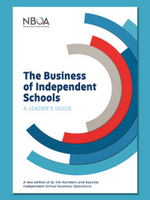In May, NBOA released, “The Business of Independent Schools: A Leader’s Guide.” This essential text outlines the primary responsibilities of the independent school business officer and key considerations to help them succeed in their leadership role.
The following article is a short excerpt of Chapter 6, “The Independent School Business Model.” In the full chapter, NBOA Executive Vice President James Palmieri breaks down the traditional independent school business model and outlines four emerging alternatives. Learn more about the book and purchase at nboa.org/LeadersGuide.
The business officer alone, head of school alone or trustees alone cannot solve a school’s financial challenges. School leadership, including division heads, admissions and advancement professionals, and others, must work together to address financial challenges for the long term. Bring others on board to solve these complex problems.
Because tuition is the largest source of revenue for an independent school, the board and administration must understand enrollment strategies as well as market trend information. The primary drivers of net tuition revenue (NTR) — student recruitment, student retention, tuition rates and financial assistance — must work in concert for the budget to be sustainable. The head of school, finance committee, business officer and enrollment director should assess if enrollment-related strategies are consistent with and follow the school’s strategic plan. The administration should routinely prepare reports on enrollment, market trends and competitor information for the finance committee and board.
On the expense side, focus closely on the people — management of FTEs (full-time equivalent employees) — and not minor field trips, supplies and physical education equipment. Particularly important is the ratio of student enrollment to total FTEs. Schools want to avoid “FTE creep,” or an increase in FTEs without an equal increase in students, which causes an imbalance in the overall ratio.
When it comes to impactful expense reduction strategies, there are several undesirable go-to’s:
- Reducing faculty FTEs.
- Reducing administration and staff FTEs.
- Increasing number of students per classroom.
- Increasing teaching load.
- Increasing employee contributions for benefits.
- Decreasing planned salary increases.
- Reducing salaries.
- Reducing benefits.
- Sunsetting student programs.
- Eliminating costly employee benefits.
Given the cutbacks many schools championed after the 2008 recession, schools may feel they cannot cut back further on staff and faculty costs, but schools can marginally chip away at compensation costs. Faculty surrogates, online learning and new compensation models offer alternatives to traditional faculty models.
Do not, however, jeopardize what makes your school distinct by underpaying and losing outstanding faculty members. In the words of NBOA President and CEO Jeff Shields, “Schools cannot feasibly forge a path toward financial sustainability on the backs of faculty. Freezing salaries is as unsustainable as 10% salary increases every year. You must look at all areas of the school enterprise and address financial challenges holistically.”
Change is difficult and uncomfortable in all organizations, but particularly in schools, which are embedded in traditions and steeped in personal relationships. These decisions must be made carefully, and even so, they may create conflict within your
community. It is easier in the short term for a school not to change, but financial challenges only grow worse than when they are ignored.





